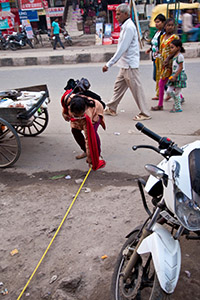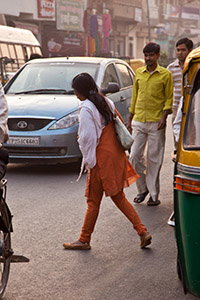Better lighting, wider pavements: steps towards preventing sexual violence in New Delhi
Date:
A young woman from Bilaspur camp, in the Molarband area of south Delhi, says she never goes to the community toilets alone. “Near the community toilet complex we have a banyan tree where boys are always standing. They harass every girl who goes to the toilet. I never go to the toilet alone, especially when it is dark,” she said, echoing the 24 other women who took part in a focus group discussion last September.

Organized as part of the Safe Cities programme, the discussion was part of a safety audit with the women along a route they use frequently in Molarband. Seven such safety audits were conducted by UN Women’s partner Jagori in five municipal areas of Delhi in late 2012, as part of the “Safer Cities Free of Violence against Women and Girls Initiative” by UN Women in partnership with UN-Habitat, the Government of Delhi and the NGO, Jagori.
The findings were analysed in January 2013 and some of its recommendations were included in the ground-breaking Justice Verma Committee report of February 2013. The Government of India appointed the Committee to review the existing laws and provisions on violence against women after the brutal gang rape and subsequent death of a 23-year-old in Delhi in December 2012. A Criminal Law (Amendment) Act 2013 was passed by the Indian Parliament and subsequently approved by the President on 3 April.
The Committee received 80,000 recommendations, including from UN Women’s Safe Cities’ partner Jagori. Among its recommendations, the report mentioned the need for changes in urban infrastructure and toilets. It also urged that better “street lighting everywhere would provide more safety since dark areas are more prone to facilitate crimes.” In addition, “Street vending should be encouraged to make the bus stops and footpaths safe for communities and pedestrians…”
“This is a result of our advocacy on creating safe cities,” says Kalpana Viswanath, Advisor for the Safer Cities Programme in India. “The safe cities movement is about broadening the discussion on how to address violence, and increasing the number of stakeholders that are involved. We now are engaging with institutions that earlier did not see a role for themselves in addressing women’s safety – from public works, urban planners to service providers.”
The audits have been conducted in low-income neighbourhoods, as well as markets, bus terminals, metro stations, and along the route that girls take to school. The findings, concluded that poor lighting near bus stops, lack of well-maintained public toilets and the absence of pavements make women feel unsafe. Also most often, women need access to services like telephone booths, police and 24-hour hospitals, especially in markets and bus terminals.
“Never before was violence against women considered an urban planning problem. But now more urban planners and policymakers are reviewing urban design – thanks to our programme,” says Sushma Kapoor, Officer-in-Charge, UN Women.

The safety audits have revealed insensitive attitudes of the police and public transport staff including drivers and conductors and identified gaps in provision and effectiveness of essential services. “I always try and leave for the metro station before it gets dark. Even the presence of the police station nearby does not have an effect on me. The entire stretch is dark – I don’t know who can come from where,” says a regular commuter of the Metro.
The Ministry of Urban Development used the recommendations this year to expand the street lighting infrastructure “There is a need for increased focus on street lighting in public places. Civic Bodies must undertake a review of the existing facilities and strengthen these wherever required,” wrote Dr. Sudhir Krishna, Secretary, Ministry of Urban Development, to Urban Development Secretaries of all Indian states.
The current efforts to engage Government and policymakers initially started in 2010 when a baseline study was used to develop the Safer Cities strategic framework.
“We did this along with different departments, from Delhi Police, to Transport, Education and the Municipal Division. In this framework, we decided to focus on public transport, civic awareness, education and urban planning,” says Mr. Rajiv Kale, Director, Department of Women and Child Development, Government of Delhi. “As a result, these departments have also started focusing on issues concerning the safety of women and girls as an essential input in planning and implementing their programmes and policies.”
The Delhi Government has adopted the safety audit methodology, giving women a voice and incorporating their concerns into planning.
“The programme has really helped to make women an equal partner in ensuring their safety … women are now able to speak of their experiences directly to the police, and tell us what is needed to be done,” says Suman Nalwa, Additional District Commissioner of Police, Special Police Unit for Women and Children.
Implementing the new anti-rape legislation is the next major challenge for all partners, as the incidence of rapes being reported in Delhi has skyrocketed in recent months, explains Suneeta Dhar, Director, Jagori, “which means women are gaining confidence and breaking the silence. And we need to provide adequate services to cater to the demands.”
Related links:
From play-acting to real-life action: a journey to end harassment on public transit in Egypt
Women’s collectives foster access to justice in India
UN Women supported survey in Delhi shows 95 per cent of women and girls feel unsafe in public spaces
UN Women condemns gang rape of Delhi student
Breaking the vicious circle of violence in local markets in Papua New Guinea
Q&A with Mayor of Quito, illustrating the Safe Cities programme